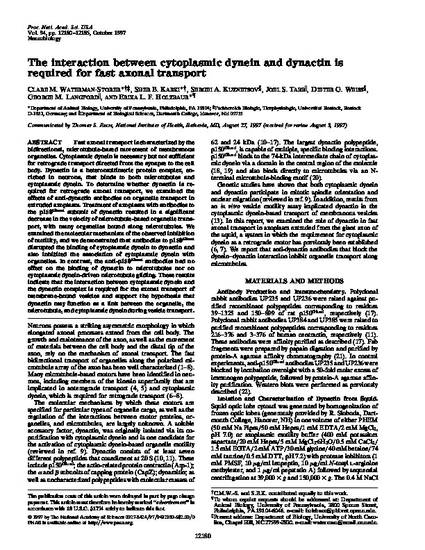
- Animals,
- Antibodies,
- pharmacology,
- Axonal Transport,
- physiology,
- Axons,
- metabolism,
- Biological Transport,
- drug effects,
- Cell-Free System,
- Cytoplasm,
- Decapodiformes,
- Dyneins,
- Microtubule-Associated Proteins,
- immunology,
- Microtubules,
- drug effects,
- ultrastructure,
- Organelles,
- physiology,
- Protein Binding
Fast axonal transport is characterized by the bidirectional, microtubule-based movement of membranous organelles. Cytoplasmic dynein is necessary but not sufficient for retrograde transport directed from the synapse to the cell body. Dynactin is a heteromultimeric protein complex, enriched in neurons, that binds to both microtubules and cytoplasmic dynein. To determine whether dynactin is required for retrograde axonal transport, we examined the effects of anti-dynactin antibodies on organelle transport in extruded axoplasm. Treatment of axoplasm with antibodies to the p150(Glued) subunit of dynactin resulted in a significant decrease in the velocity of microtubule-based organelle transport, with many organelles bound along microtubules. We examined the molecular mechanism of the observed inhibition of motility, and we demonstrated that antibodies to p150(Glued) disrupted the binding of cytoplasmic dynein to dynactin and also inhibited the association of cytoplasmic dynein with organelles. In contrast, the anti-p150(Glued) antibodies had no effect on the binding of dynactin to microtubules nor on cytoplasmic dynein-driven microtubule gliding. These results indicate that the interaction between cytoplasmic dynein and the dynactin complex is required for the axonal transport of membrane-bound vesicles and support the hypothesis that dynactin may function as a link between the organelle, the microtubule, and cytoplasmic dynein during vesicle transport.